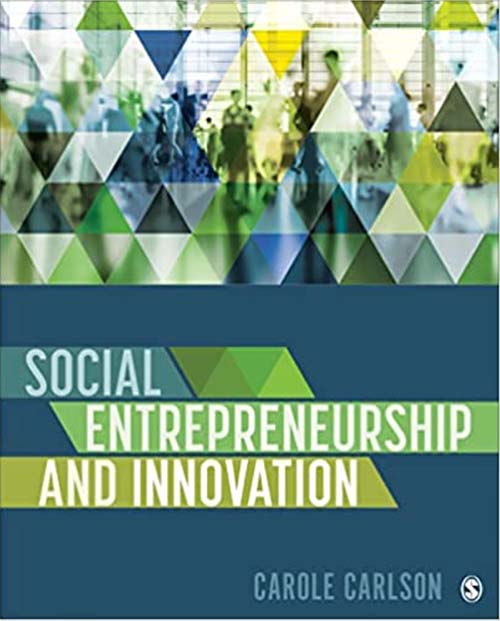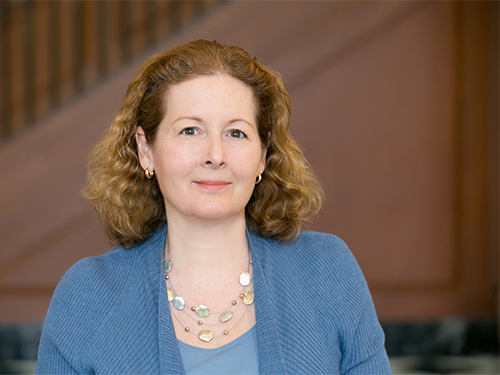By Bethany Romano, MBA’17
Carole Carlson, director of the Heller School’s Social Impact MBA program, has authored a comprehensive textbook on social entrepreneurship, a rapidly growing specialty field that examines the expansive ecosystem of mission-driven business ventures and trains motivated students to join their ranks. The book, titled “Social Entrepreneurship and Innovation,” was published by SAGE in February 2022 to critical acclaim. Peer reviewers describe it as “theory rich,” “easy to read and easy to teach,” and “the first comprehensive text that I have found.”
Heller Communications spoke with Carlson about the new book and her long career teaching social entrepreneurship to Heller students.
Congratulations on this monumental achievement. Reviewers noted that your textbook fills an important gap in the marketplace. As a longtime professor of social entrepreneurship, can you tell us about that gap?
I’ve been teaching social entrepreneurship for over a decade. As an instructor, I was consistently challenged by the lack of high-quality explanations of the elements that make social ventures viable and scalable. There were books that were vague around “doing good” but lacked structure, and books that were devoid of theory and were more just a series of stories. Plus, a lot of the existing material was very old.
The same was true for case studies: there just wasn’t much out there. I’m interested in cases about diverse entrepreneurs who were really challenged to make their ventures work. There were cases that told good stories but lacked details, and plenty of good cases about entrepreneurial finance that lacked the mission-driven component. I always felt like I was teaching a case that didn’t quite fit.
For that reason, a number of years ago I started writing my own cases. And I wanted a diverse mix of cases: some well-known social entrepreneurs who are really established, but also some people in their twenties who my students might relate to more.
So, when SAGE publishing approached me and said, “we think there’s a gap in the marketplace,” it aligned with my own experience, and I thought I could contribute.
When you say many of the existing case studies on social entrepreneurs lacked structure or theory, what do you mean by that?
If social entrepreneurship is going to be taken seriously as a catalyst for social change, we can’t just provide feel-good stories about positive outcomes. We need serious, robust case studies about financial models, business models, how to assess markets and organize ventures, leadership and operations management. These are of course all the things you need to launch a traditional entrepreneurial venture, but with the addition of a social lens.
We can’t hold social entrepreneurs to lower standards, when in reality they have to meet the same – or usually higher – standards as any entrepreneur. In any kind of venture, social or commercial, you need to attract a team, deliver value for customers and have a financial model that keeps the lights on. Social ventures might rely more on philanthropy or other capital markets and take a different approach to measuring impact, but they all need to be financially viable. If we just talk about a given social venture as “wonderful” and “inspiring,” when it’s actually not making ends meet, or not scaling, we’re not doing the social entrepreneur any favors or helping our students by using them as an example.
Can you tell us more about the case studies you selected and wrote for this textbook?
At the start of this project, I sat down with a wide range of experts and got advice about social entrepreneurs who were doing really interesting work that had been overlooked. At the Heller School I’ve been lucky to be exposed to lots of social entrepreneurs, many of them graduates of our own Social Impact MBA program. Some of them became the subjects of my cases, but I also wanted to look outside of Heller and, in particular, to take a global focus.
I had the opportunity – which I loved – to interview over 50 successful entrepreneurs, some of them my personal heroes. This book also incorporates the stories of many social entrepreneurs who had never really been studied in a business school context. Unlike some of the older and more traditional books on the market, I wanted to look at a diverse set of entrepreneurs. The book introduces readers to social ventures in Mexico, Vietnam, sub-Saharan Africa, New Zealand, Israel and Gaza as well as throughout the United States. I intentionally included women entrepreneurs and entrepreneurs of color, entrepreneurs who were not Ivy-League educated and younger social entrepreneurs, all of whom are sometimes overlooked but starting and operating innovative social ventures.
How do you envision instructors and students using this book in the classroom?
This book is essentially “a course in a box,” and it’s structured very intentionally to be highly teachable, which arose from my own desire to have a better teaching tool. Each chapter includes a short profile of a social entrepreneur, a mini-case study, a section on theory and key concepts, and a series of application exercises. It also includes guiding questions and everything an instructor might need to use each part of each chapter so they can go deep, but also make it experiential and real for the students.
The book walks readers through a semester-long process to develop their own entrepreneurial venture including a business pitch. That’s how I structure my class: we start with idea generation, discuss how to create teams, build systems, decide on financial and legal structures, scale initial ideas, measure impact, pitch ideas effectively, and so forth. By the end of the course, students develop a team-based social venture that, in my class, they pitch to a panel of judges.
It’s a very hands-on and very applied learning experience, and in some cases that process has yielded truly viable business ideas that have gone on to become real social ventures. My hope is for this textbook to guide students in social entrepreneurship classrooms far beyond the Brandeis campus through this same process and into founding social ventures of their own.


